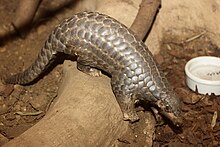Chinese pangolin
[3] In the 19th century and 20th centuries, several Chinese pangolin specimens were collected and described: The Chinese pangolin is native to southern Nepal, northeast India, Bhutan, Bangladesh, Myanmar, northern Indochina, southern China including the island of Hainan and most of Taiwan.
[8] Currently, confirmed populations in mainland China are known in Yunnan, Hainan, Guangxi, Guangdong, Hunan, Chongqing, Fujian, Jiangxi, Zhejiang and Anhui provinces.
Its hard scales work as a protective cover from predators, and when it feels threatened, it curls into a ball ("volvation").
It digs into ant nests and termite mounds with its large fore claws and extracts insects with its long, sticky tongue.
[11] Gut contents of a wild juvenile individual killed by dogs in Hong Kong on November 24, 2013 included only 25,803 ants and 812 termites, representing 6 genera and 9 species.
Since the 1970s "pangolins are now almost unknown to visitors and are exhibited infrequently in zoos", and have "historically been difficult to maintain, with most captive animals dying within a short period after capture".
When in their natural habitat, this species lives "on a diet of ants, termites, and various other invertebrates including bee larvae, flies, worms, earthworms, and crickets".
After carefully creating new, more sustainable recipes in zoos, some of the ingredients used have included "egg, meat (ground beef, horse, canned feline diet), evaporated milk products, milk powder, fish protein, orchid leaves, commercial chows, psyllium seed, carrots, yeast, multivitamins, and insects (mixtures of silkworm larvae, earth, ants, termites, meal worms, or crickets)".
A number of zoos that have kept pangolins under observation have found that the animals died most commonly after a few years, without breeding successfully.
The Convention on International Trade in Endangered Species of Wild Fauna and Flora reports that pangolins are the most trafficked and poached mammal.
[16] Chinese pangolin scales are sold to treat a wide variety of ailments, from cancer to upset stomach to asthma.
After random inspections in May 2014, at the Kwai Chung Container Port in Hong Kong, officials detained scales from nearly 8,000 pangolins.
Some of the plan's highlights include making protocols to monitor pangolin populations, establishing a consumption index of pangolin products, using DNA analysis to determine variation between and within species, and identifying species strongholds to determine best allocation of resources.
[23] Another alternative to legislation, proposed by IUCN, includes offering positive incentives, like monetary payments or control over land's resources, to local communities for their involvement in conservation efforts.
[24][failed verification] Other researchers have proposed the importance of finding biological substitutes for endangered species used in traditional medicines.
Since July 2017, the Beijing-based NGO has established three Chinese pangolin Community Conservation Areas in Hunan, Guangxi and Jiangxi provinces.


